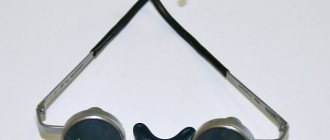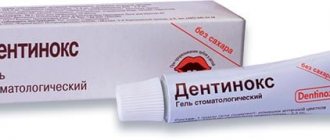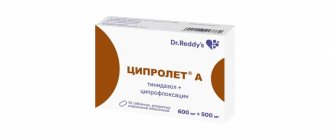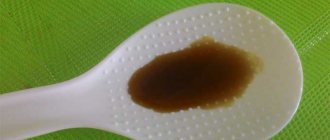Indications and contraindications for use
Scandinibs solution is used in dental practice for local anesthesia. It is possible to use the medicine in patients with pathologies of the cardiovascular system, glaucoma, and other diseases, since it does not have a vasoconstrictor effect.
It is strictly forbidden to use an anesthetic in the following cases:
- cannot be used in the treatment of children under 4 years of age;
- if there is an individual intolerance to the main component of the solution – mepivacaine;
- history of liver disease;
- renal failure.
It is necessary to use the solution with extreme caution when:
- a shift in the acid-base balance towards acidity - with acidosis;
- in childhood and old age;
- heart problems;
- chronic diseases of various types;
- hyperkalemia;
- pregnancy and lactation.
To relieve pain during dental procedures during pregnancy, the anesthetic Scandinibsa is a fairly safe method of anesthesia. The drug has no effect on the course of pregnancy. But, as with any other medical intervention, the risk for the child and the benefit for the woman should be assessed.
The active substance does not penetrate into milk, since during dental use a minimal amount of solution is administered.
Scandinibsa forte
Active ingredient Mepivacaine + Epinephrine Dosage form: Solution for injection.
Composition: 1 ml of the drug contains: Active ingredients: - mepivacaine hydrochloride - 20 mg - epinephrine hydrotartrate - 12.73 mcg (equivalent to epinephrine) - 10 mcg * Excipients: sodium chloride, sodium metabisulfite**, methyl parahydroxybenzoate, hydrochloric acid solution 2M, sodium hydroxide solution 2M, water for injection. * corresponds to the content of epinephrine in a solution of 1: 100,000 ** 10% excess (another name is sodium disulfite)
Description: Transparent colorless solution.
Pharmacotherapeutic group: Local anesthetic + alpha and beta adrenergic agonist
ICD-10: XXI.Z40-Z54.Z51.4 Preparatory procedures for subsequent treatment, not classified elsewhere
ATC: N.01.BB53 Mepivacaine in combination with other drugs
Pharmacodynamics: A combined drug, the effect of which is determined by the components included in its composition. Blocks voltage-dependent sodium channels, prevents the generation of impulses at the endings of sensory nerves and the conduction of impulses along nerve fibers. Mepivacaine is an amide-type local anesthetic. When administered by injection near sensory nerve endings or nerve fibers, mepivacaine reversibly blocks the transmission of pain impulses in the central nervous system. Epinephrine added to a local anesthetic solution slows down the absorption of mepivacaine, maintaining a high concentration at the injection site, which enhances its effect and allows the dose of the administered drug to be reduced. Anesthesia is enhanced and prolonged, bleeding during surgical interventions is reduced. Anesthesia sets in quickly. The onset of the effect is 2-3 minutes, the duration of action is from 130 to 160 minutes.
Pharmacokinetics: When administered into the tissues of the maxillofacial area through conduction or infiltration anesthesia, the maximum concentration of mepivacaine in the blood plasma is achieved approximately 30 minutes after the injection. The half-life (T1/2) is long and is approximately 90-120 minutes. Mepivacaine is metabolized quite quickly and only 5-10% is excreted unchanged through the kidneys. Having an amide structure, mepivacaine is not metabolized by plasma esterases. Most of the anesthetic and its metabolites are eliminated by the liver after 30 hours. In case of liver pathology (cirrhosis, hepatitis), accumulation of mepivacaine is possible. Epinephrine administered parenterally is rapidly destroyed. Metabolized mainly by monoamine oxidase and catechol-O-methyltransferase in the endings of sympathetic nerves and other tissues, as well as in the liver with the formation of inactive metabolites. Excreted by the kidneys in the main form of metabolites: vanillylmandelic acid, sulfates, glucuronides; and also in small quantities - unchanged.
Indications: Scandinibsa® forte is used for infiltration, conduction, intraligamentary, intraosseous and intrapulpal anesthesia during surgical and other painful interventions in dentistry.
Contraindications: - Hypersensitivity to mepivacaine (including other amide-type local anesthetics); - Hypersensitivity to sulfites; — Introduction into the submucosa of the palate; — Severe myasthenia; — Malignant hyperthermia; — Cardiovascular diseases: arrhythmia, heart pathology, coronary heart disease, arterial hypertension; — Epilepsy; — Angle-closure glaucoma; — Severe renal failure: cirrhosis, porphyria; - Bronchial asthma; — Thyrotoxicosis; — Acute form of diabetes mellitus; - Simultaneous use of MAO inhibitors and tricyclic antidepressants; — Children under 4 years of age. With caution: - Conditions accompanied by a decrease in hepatic blood flow (for example, chronic heart failure, diabetes mellitus, liver disease); — Progression of cardiovascular failure; — Inflammatory diseases or infection of the injection site; — Pseudocholinesterase deficiency; — Kidney failure; - Hyperkalemia; - Acidosis; — Old age (over 65 years); — Children's age (over 4 years).
Pregnancy and lactation: During pregnancy, local anesthesia is considered the safest method for relieving pain during dental procedures. The drug does not affect the course of pregnancy. However, as with any therapy, it is necessary to assess the degree of benefit to the mother and the risk to the fetus, especially in the first trimester of pregnancy. Mepivacaine does not pass into breast milk in any significant quantities because, when used during dental procedures, it is administered in small doses, which are quickly metabolized and eliminated. If it is necessary to use the drug during lactation, it is necessary to balance the benefits for the mother and the risk for the baby.
Method of administration and dosage: The amount of solution and the total dose depend on the type of anesthesia and the nature of the surgical intervention or manipulation. The average single dose is 1.8 ml (1 cartridge). Maximum dose for: - adults and children weighing more than 30 kg - 5.4 ml; - children weighing 20-30 kg - 3.6 ml; - children weighing less than 20 kg - 1.8 ml. The maximum daily dose of mepivacaine is 4.0 mg/kg body weight, but not more than 320 mg.
Side effects: Occur due to accidental intravascular administration, resorption from inflamed or highly vascularized tissue. This drug contains sodium metabisulfite as an excipient. Therefore, it may cause allergic reactions, including anaphylactic shock and bronchospasm, in susceptible patients, especially those with a history of allergies and asthma. - From the central nervous system and sensory organs: dizziness, motor restlessness, tinnitus, headache, drowsiness, weakness, disturbances of consciousness, including loss of consciousness, convulsions, trismus, tremor, visual and auditory disturbances, blurred vision, diplopia , nystagmus. - From the cardiovascular system: decreased blood pressure, collapse (peripheral vasodilation), arrhythmias (bradycardia, tachycardia), AV block, chest pain. - From the digestive system: nausea, vomiting. - Blood disorders: methemoglobinemia. - From the respiratory system: dyspnea, apnea. — Allergic reactions: skin itching, skin rash, angioedema, other anaphylactic reactions (including anaphylactic shock), urticaria (on the skin and mucous membranes). — Other: hypothermia, decreased potency, loss of sensitivity and paresthesia of the lips and tongue. — Local reactions: swelling and inflammation at the injection site.
Overdose: Symptoms: Lungs - dizziness, nausea, vomiting, agitation, tinnitus; Severe - a sharp drop in blood pressure, rapid breathing, rare breathing, tachy- or bradycardia, AV block, convulsions, coma, respiratory paralysis. Measures: - When the first signs of an overdose appear (dizziness, motor restlessness, loss of consciousness, decreased blood pressure, tachycardia, bradycardia), it is necessary to stop administering the drug, place the patient in a horizontal position, ensure an open airway, monitor the heart rate and blood pressure. - For dyspnea, apnea - oxygen, endotracheal intubation, artificial ventilation (central analeptics are contraindicated). - For convulsions - slow intravenous short-acting barbiturates with simultaneous oxygen intake and hemodynamic control. - In case of severe circulatory disorders and shock - intravenous infusion of electrolytes, glucocorticosteroids, plasma substitutes, albumin. - For vascular collapse and increasing bradycardia - epinephrine (Adrenaline) 0.1 mg slowly intravenously, then intravenously by drip under the control of heart rate and blood pressure. - For severe tachycardia and tachyarrhythmia - intravenous beta-blockers - For increased blood pressure in patients suffering from arterial hypertension - peripheral vasodilators. Oxygen administration and circulatory control are necessary in all cases.
Interaction: With simultaneous use of mepivacaine with beta-blockers, slow calcium cord blockers (SCBs) and other antiarrhythmic drugs, the inhibitory effect on myocardial conductivity and contractility increases. Prescribing mepivacaine while taking MAO inhibitors (furazolidone, procarbazine, selegiline) increases the risk of lowering blood pressure. Vasoconstrictors (epinephrine, norepinephrine, methoxamine, phenylephrine) prolong the local anesthetic effect of mepivacaine. Mepivacaine enhances the inhibitory effect on the central nervous system caused by other drugs. When mepivacaine is used simultaneously with anticoagulants (ardeparin sodium, dalteparin, enoxaparin, heparin, warfarin), the risk of bleeding increases. When treating the mepivacaine injection site with disinfectant solutions containing heavy metals, the risk of developing a local reaction in the form of pain and swelling increases. Mepivacaine enhances and prolongs the effect of muscle relaxant drugs. When mepivacaine is prescribed with narcotic analgesics, an additive inhibitory effect on the central nervous system develops. Mepivacaine exhibits antagonism with antimyasthenic drugs in its effect on skeletal muscles, especially when used in high doses, which requires additional adjustment in the treatment of myasthenia gravis. Cholinesterase inhibitors (antimyasthenic drugs, cyclophosphamide, thiotepa) reduce the metabolism of mepivacaine.
Special instructions: In some sensitive patients, the administration of the drug may be accompanied by impaired reaction when driving a car. The doctor must decide on a case-by-case basis whether the patient is able to drive a car or operate machinery. Use only in a medical facility. Eating is possible only after sensitivity has been restored. The appearance of an air bubble in the carpule indicates a violation of the temperature conditions of storage or transportation, which can lead to a decrease in the activity of the vasoconstrictor.
Release form/dosage: Solution for injection 20 mg/ml + 10 mcg/ml
Packaging: In a 1.8 ml cartridge made of colorless borosilicate glass type I EF, on which a label is glued. The cartridge is sealed at one end with a gray elastomer plunger, at the other end with an elastomer disk, which has a corresponding rolled aluminum cap. 10 cartridges are placed in a blister pack made of transparent thermoplastic and paper with a laminated coating, hermetically sealed. 10 blister packs along with instructions for use are placed in a cardboard box.
Storage conditions: Store in a dry place, protected from light, at a temperature not exceeding 25°C. Keep out of the reach of children.
Shelf life: 2 years. Do not use after the expiration date indicated on the packaging.
Conditions for dispensing from pharmacies: By prescription.
Mode of application
The dosage directly depends on the type of intervention and on the specific type of anesthesia used: conduction, infiltration, intrapulpal, intraosseous.
The average single dose is one cartridge. Cartridge filling: 1.8 ml.
The amount of drug administered during one visit to the dentist should not exceed:
- 5.4 ml (or 3 cartridges) for children weighing more than 30 kg and adults.
- 3.6 ml (or 2 cartridges) for children weighing from 20 to 30 kilograms.
- 1.8 ml (or one cartridge) for children weighing less than 20 kg.
Maximum: 4 mg per kilogram of weight, but not more than 320 milligrams.
Special instructions when using an anesthetic
The drug can only be used under the supervision of a specialist in a medical facility. You can eat food after recovery of sensitivity.
After the injection, driving is not advisable.
Application in pediatric dentistry
Scandonest is used in pediatric dentistry, as it provides 100% pain relief and does not cause negative side effects. This is especially true for young patients under five years of age for whom adrenaline is contraindicated. After the age of five, children can be treated for pain with drugs containing adrenaline, for example, Ultracain DS. The dosage of the medicine corresponds to the age of the small patient.
The dentist’s work with the child should be carried out with the child’s complete trust in the doctor. After pain relief, the child gains confidence in the dentist and allows the necessary therapy to be carried out.
Possible adverse reactions
In case of individual intolerance to the active substance of the solution, the following negative reactions are possible:
- from the cardiovascular system (cardiovascular system) the following is noted: decreased pressure, tachycardia, chest pain, bradycardia, arrhythmia;
- Central nervous system : headache, general weakness, dilated pupils, dizziness, numbness of the tongue and lips, possible loss of consciousness; cessation of breathing – apnea;
- urinary system : involuntary urination is noted;
- in the blood is increased - methemoglobinemia;
- digestive system : vomiting, problems with stool, pain and cramping in the abdomen;
- local reactions : edema may form at the injection site.
If any of the above symptoms are detected, the use of the solution is stopped, treatment is symptomatic.
Description of the drug
Scandonest without adrenaline is produced in blisters of 10 ampoules each. The drug is intended for professional use and is administered by injection into soft tissue.
Compound:
- mepivacaine hydrochloride;
- sodium hydroxide;
- sodium chloride;
- saline solution
The active ingredient of Scandonest is mepivacaine hydrochloride, the action of which is aimed at blocking the nerve impulses responsible for pain. Unlike other painkillers, Scandonest is characterized by a vasoconstrictor effect. This is radically opposite to the effect of medications that dilate the lumen of blood vessels.
Note! Scandonest is used for pain relief in patients for whom adrenaline is contraindicated.
The anesthetic effect lasts at least 30 minutes and occurs 3-4 minutes after administration of the drug. After 1.5 hours, the drug is partially eliminated from the body. However, it should be borne in mind that no more than 10% of the drug is excreted by the kidneys; the liver takes the brunt. Therefore, any pathological changes in the liver can lead to problems.
Note! When using local anesthetics, the patient remains conscious and responds adequately to the situation.
The result of using Scandonest is loss of sensitivity to pain. There is not even any unpleasant sensation. Before administering the medicine, the dentist freezes the area so that there is no discomfort during the injection. After the drug begins to act, therapy takes place in a calm environment.
Cases of overdose
If the recommended dose of the administered drug is exceeded, overdose symptoms may develop:
- Light form . Manifested by nausea, vomiting, weakness, dizziness, tinnitus.
- Severe form . It manifests itself as a decrease in pressure, bradycardia and tachycardia, increased or complete cessation of breathing, and coma.
In this case, stop using the solution. Help should be aimed at relieving symptoms.
Bottom line
Tooth extraction, removal of pulpitis and operations on soft tissues of the oral cavity should be carried out under local anesthesia. Scandonest in dentistry is a new generation anesthetic based on mepivacaine, which does not contain adrenaline. It can be administered to patients sensitive to the effects of adrenaline and who have contraindications to the use of lidocaine. This drug is also used in gynecology and in the treatment of other diseases.
Sources used:
- Solovyova A. A. (2015) Fundamentals of anesthesiology. Local and general anesthesia
- Manufacturer website Septodont (France)
- Anesthesiology and resuscitation, ed. Dolina O. A., M. GEOTAR-Media, 2006
- Bernardsky Yu. I. Fundamentals of maxillofacial surgery and surgical dentistry. - M.: Medical literature, 2000.









